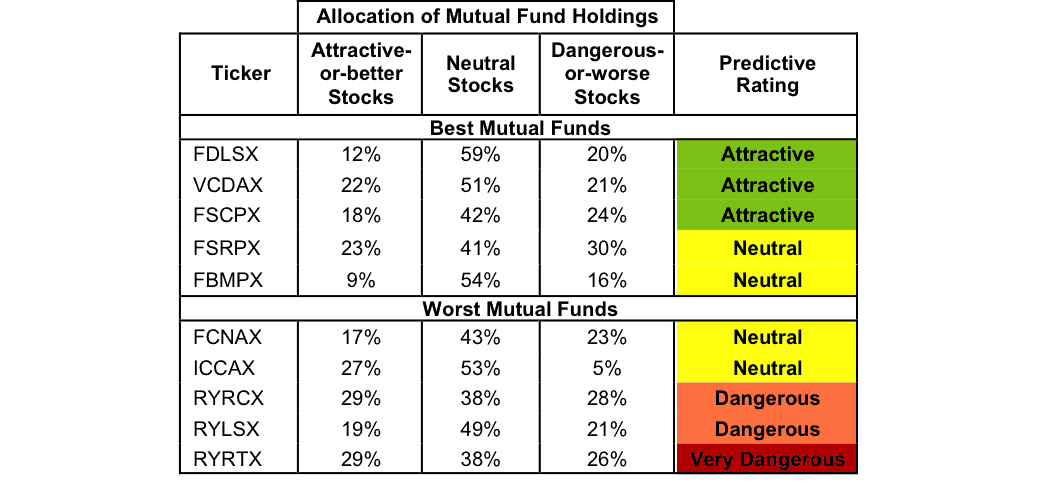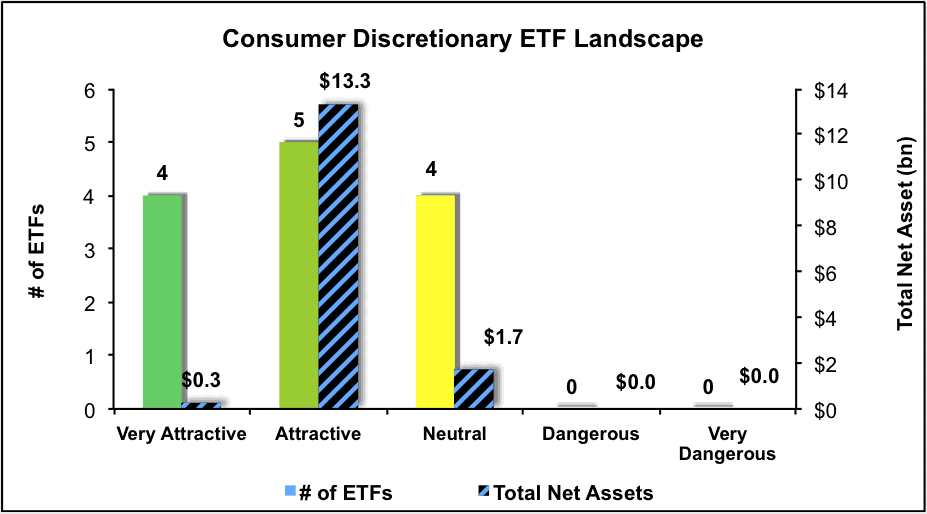Sector Analysis 3Q16
The Consumer Discretionary sector ranks second out of the ten sectors as detailed in our 3Q16 Sector Ratings for ETFs and Mutual Funds report. Last quarter, the Consumer Discretionary sector ranked fifth. It gets our Neutral rating, which is based on aggregation of ratings of 13 ETFs and 19 mutual funds in the Consumer Discretionary sector as of July 11, 2016. See a recap of our 2Q16 Sector Ratings here.
Figure 1 ranks all eight ETFs that meet our liquidity standards and Figure 2 shows the five best and worst rated Consumer Discretionary mutual funds. Not all Consumer Discretionary sector ETFs and mutual funds are created the same. The number of holdings varies widely (from 25 to 393). This variation creates drastically different investment implications and, therefore, ratings.
Investors seeking exposure to the Consumer Discretionary sector should buy one of the Attractive-or-better rated ETFs or mutual funds from Figures 1 and 2.
Figure 1: ETFs with the Best & Worst Ratings – Top 5
* Best ETFs exclude ETFs with TNAs less than $100 million for inadequate liquidity.
Sources: New Constructs, LLC and company filings
Five ETFs are excluded from Figure 1 because their total net assets (TNA) are below $100 million and do not meet our liquidity minimums. See our ETF screener for more details.
Figure 2: Mutual Funds with the Best & Worst Ratings – Top 5
* Best mutual funds exclude funds with TNAs less than $100 million for inadequate liquidity.
Sources: New Constructs, LLC and company filings
ICON Consumer Discretionary Fund (ICCCX) and Rydex Leisure Fund (RYLIX, RYLAX) are excluded from Figure 2 because their total net assets (TNA) are below $100 million and do not meet our liquidity minimums.
PowerShares Dynamic Leisure & Entertainment Portfolio (PEJ) is the top-rated Consumer Discretionary ETF and Fidelity Select Leisure Portfolio (FDLSX) is the top-rated Consumer Discretionary mutual fund. PEJ earns a Very Attractive rating and FDLSX earns an Attractive rating.
iShares US Consumer Services ETF (IYC) is the worst rated Consumer Discretionary ETF and Rydex Series Retailing Fund (RYRTX) is the worst rated Consumer Discretionary mutual fund. IYC earns a Neutral rating and RYRTX earns a Very Dangerous rating.
443 stocks of the 3000+ we cover are classified as Consumer Discretionary stocks.
NVR Inc. (NVR: $1,770/share) is one of our favorite stocks held by FXD and earns a Very Attractive rating. NVR is also on June’s Linking Executive Comp to ROIC Model Portfolio. Over the past five years, NVR has grown after-tax profit (NOPAT) by an impressive 30% compounded annually. Over this same time, NVR has improved return on invested capital (ROIC) from 12% in 2011 to a top-quintile 20% over the trailing twelve months (TTM). Most impressive is that NVR has earned positive economic earnings in every year of our model, which dates back to 1998. Despite the strong fundamentals, the stock remains undervalued. At its current price of $1,770/share, NVR has a price to economic book value (PEBV) ratio of 1.1. This ratio means the market expects NVR’s profits to grow only 10% from current levels over the remaining life of the business. If NVR can grow NOPAT by 7% compounded annually for the next decade, the stock is worth $2,600/share today – a 47% upside.
Sears Holdings Corp (SHLD: $13/share) is one of our least favorite stocks held by Consumer Discretionary ETFs and mutual funds and earns a Very Dangerous rating. Sears Holdings was in the Danger Zone in April 2013 and the stock remains overvalued. Sears’ NOPAT has declined from $1.4 billion in 2006 to -$911 million in 2016. Over the trailing twelve months, NOPAT has declined even further to -$1.3 billion. Similarly, Sears’ ROIC has declined from 9% in 2006 to a bottom quintile -9% TTM. Despite the issues at SHLD being widely known, and the stock falling drastically, the stock remains overvalued. To justify its current price of $13/share, SHLD must immediately achieve pre-tax margins of 5% (highest level ever achieved in our model, compared to -6% TTM) and grow revenue by 11% compounded annually for the next 13 years. For reference, Sears last achieved positive revenue growth in 2007 and consensus estimates expect revenue declines for the next two years. We think it is safe to say the expectations for future profits baked into the current stock price appear too high.
Figures 3 and 4 show the rating landscape of all Consumer Discretionary ETFs and mutual funds.
Figure 3: Separating the Best ETFs From the Worst ETFs
Sources: New Constructs, LLC and company filings
Figure 4: Separating the Best Mutual Funds From the Worst Mutual Funds
Sources: New Constructs, LLC and company filings
This article originally published here on July 12, 2016.
Disclosure: David Trainer and Kyle Martone receive no compensation to write about any specific stock, sector or theme.
Click here to download a PDF of this report.
Photo Credit: the-difference (Flickr)




